8/9/04 - day 5 |
| Headwaters of the Copper River |
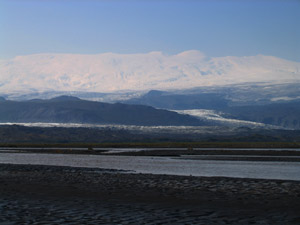 |
We rafted almost from our camp last night. Out to the lake and into the river, which braided out into a swift muddy flow, with Wrangell and the Copper Glacier looming over us upstream. The smoke had cleared away since yesterday, and the huge mountains towering over our valley looked even larger than they had before. Sanford is large and elegant, with a classical domed mountain shape. Wrangell is massive. Wrangell is a wide plain of white that looks more like a cloudbank than a mountain. They are impressive. I ran myself into a gravel bar in the Copper while looking at Sanford, and we've taken way too many pictures of all the big mountains.
|
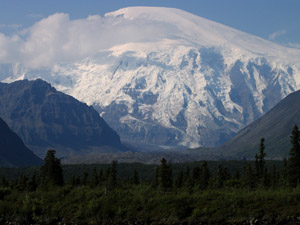 |
|
The Copper River quickly left its braid plain behind and left us with only a single channel to raft in. It was a single channel for many miles, and all of those miles were in rapids. Not huge rapids. There weren't many holes, and we could scoot around most of the largest standing waves. But there were waves everywhere. There were choppy nasty waves through the whole of it, and even if the boat passes over 95% of the waves with no trouble, the other one in twenty are enough to make you very wet.
| 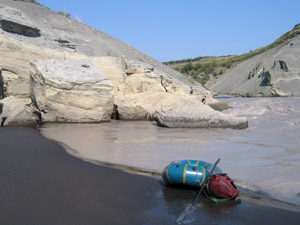 |
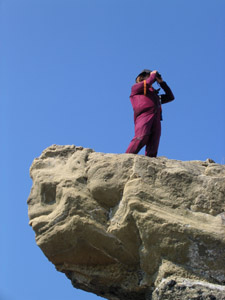 |
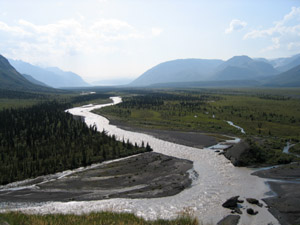 |
Luckily it was a bright and sunny day, as usual. We easily dried out almost all of our wet gear, and some of the soaked food from the soggy Ursacks. Almost all days this summer seem to be hot and sunny, and all the glacial rivers are in flood.
We had a great meal by the river's edge. Then we packed up, counted calories remaining, and decided to subsist on cookie crumbs the rest of the day. Rationing is hard. We'll see how well we all do this time. |
|
We dawdled enough that our climb up the ridge was shaded. We filled water in the Copper River, debated the possible carcinogenic qualities of silt, dumped it all out in favor of a clear water trickle full of actual dirt, and finally for a real clearwater stream on the ridge. The climb was a mess of alder and dwarf birch, but the ridge was beautiful, and not a plain of tussocks as we had feared it might be.
|
|
We're camped on a ridge almost overlooking Drop Glacier. I haven't actually looked over the edge yet, but we pushed until almost dark to get here. It's our first camp with not-so-dry ground, and the breeze adds a chill to the air. With that and my rafting damp fleece, I am highly motivated to put this down and scoot further down into the sleeping bag. |
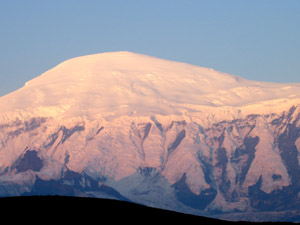 |
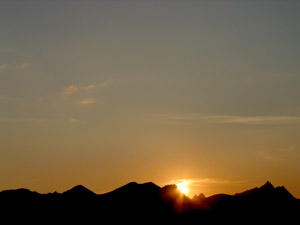 |
|
8/10/04 - day 6 |
| Drop Glacier |
|
W I usually think of a glacier as a vast plain of ice, sometimes crisscrossed with crevasses. The one we crossed today was a maze of icy mounds and peaks, draped in gravel, boulders, and mud. Drop Glacier begins where the Sanford ice fields end, flowing out as a mass of irregular ice waves, mostly hidden by their drapery of sediment. It was hard to tell where the glacier ended and the ice-cored moraines began. It was about a mile across the glacier. |
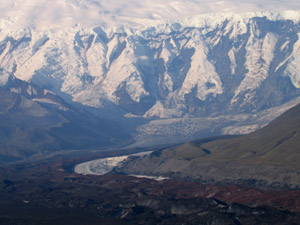 |
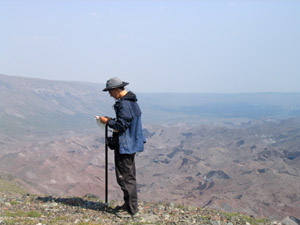 |
I was fairly skeptical of the crossing. Steep faces of ice peeked out from the hills all across the maze of glacier, and we couldn't quite see everything to the other side. But it was a shorter way, and hey, it involved us being on a glacier. And it ended up largely as a series of small obstacles. We did a lot of traversing around steep ice faces and crossed two ice-bottomed streams. The first one was silty water, and I waded right in before I realized the whole streambed was ice, and nearly fell in getting out to a better crossing spot.
|
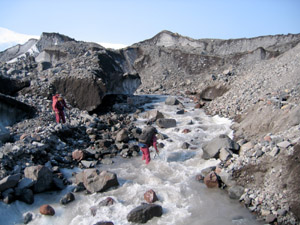 |
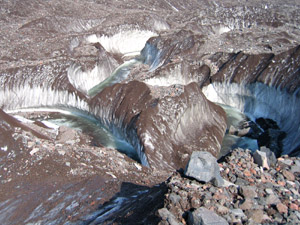 |
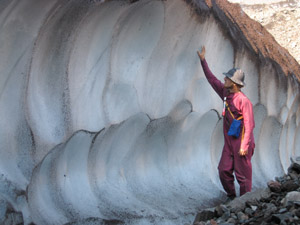 |
We had to cut a step or two in a couple spots, but the thing that almost stopped us was right at the very end. Two hours and one mile across this tricky glacier, we ended up right on its edge, looking down at a hundred foot cliff of melting ice. It would have been sad to turn back there. Luckily we found a rock bottomed gully that snuck down just on the edge of the cliff. |
|
And we were off again, cruising up and down, across nice moss and cruddy boulder, off to the next glacial valley. But today we were stalked by the caribou. The large caribou of the pair had an enormous yellow radio collar around its neck. The smaller one looked unmarked and without antlers, and followed its companion's (mother's?) lead. They were curious. As we watched them through binoculars and camera lenses, they would prance along a couple hundred feet in an indirect approach. Then they would stop, turn in unison, and stare at us curiously. Each time they got a little closer, but they stayed well out of bear-charging range. I love watching caribou move. They pick their skinny legs up high, and gracefully prance across the landscape. These two followed us even after we stopped watching them and turned back to climbing. They were keeping track of us long enough to be sure we weren't going to sneak around behind them and attack, I guess.
|
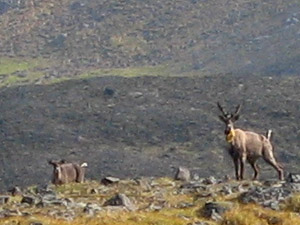 |
|
It was hot today again, but we had several very welcome cloud breaks. And there was water to be found, which is especially useful now that David's 2L platypus bottle has sprung a leak and gone to its demise. Why is so much gear made so poorly? And we walked on a lot of rocks. My feet were made sad by the rocks, and appreciated our siesta at an otherwise completely unremarkable tundra stream bank. As is often true on a longer trip, most of the break time ends up being spent repairing feet and gear. I fear we
will run out of medical tape before we run out of food or time on this trip.
| 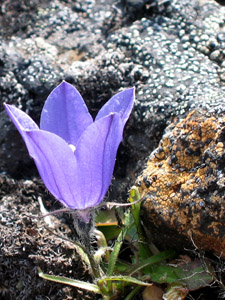 |
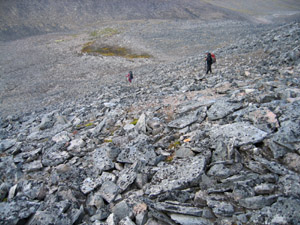 |
|
We stopped earlier than we intended to today, running smack up against a sketchy glacial river crossing. We might have done it, but the roiling brown angry water did not look inviting, even in the best of spots. And crossing with the three people can be awkward.
In keeping with our leisurely pace for the trip, we decided to wait for the morning low water. The campsite here gave us many blueberries and a great spot for a fire. We ate well, scarfing down split peas and couscous with oil and dried veggies, drinking hot chai and cocoa. Thoughts of food are taking up more space and time in my mind, but I think our rationing attempt is working ok so far. It will be even easier if we find a lake of fish.
|
|
8/11/04 - day 7 |
| Big country |
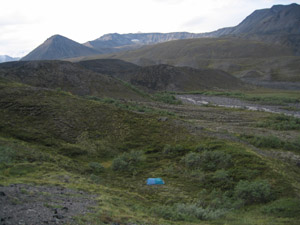 |
The Brooks Range may have been the vastest place I have ever been, but the Wrangells are certainly the biggest. Today we walked towards Mt. Drum on the flanks of Sanford. The peak of Sanford was cut off by clouds, but its ridges and ice fields filled the left half of the sky.
|
|
Sanford's west flank is a great plain of high tundra, marked by small knolls and ridges, and encircling a hundred muddy ponds. We rounded the mountain on a wide an enormous and slightly tilted field of grass, sloping away in the distance to the even larger Copper River valley.
The creek we camped at was easy to cross in the morning, and Sheep Creek was tiny. The only river we had to worry about came out of a glacier that had no name. It was bigger than any creek we'd waded so far, and we speculated that we might cross it at the end of the glacier, or we might have to follow it down into the flats to raft across. I proposed that there might be a bridge. It turns out I was right. |
 |
The river was hidden from view by a valley full of old moraine piles, but at the end of it all was an ice bridge, more than thick enough to span the river safely, and covered with many feet of rocks and gravel for easier walking. Not that moraine rocks make for very easy or comfortable walking. I and my feet are definitely tired of walking on rock piles. |
|
Most of the day we were cruising, though, and we've caught up with our way too fast schedule. We walked for 18 miles, and my feet sure feel them. Our siesta on a high up lakeshore was nice for a nap, but even the views of Sanford and Drum didn't quite entice us to spend a whole day sitting on a plain of lumpy grasses. |
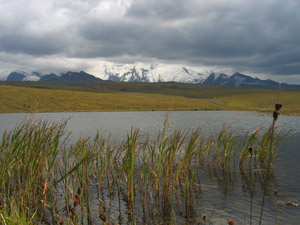 |
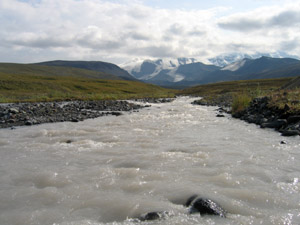 |
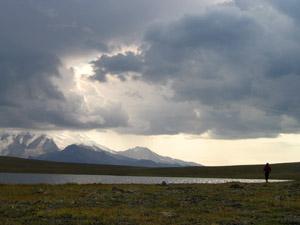 |
So we kept walking. Dark clouds moved in threatening arcs across the sky, drenching Sanford and nailing Drum. We walked in a bizarre and fortunate weather pocket, watching the storms and even hearing a peal of thunder, but not getting hit by the rain. |
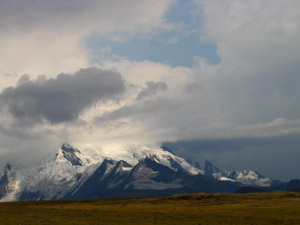 |
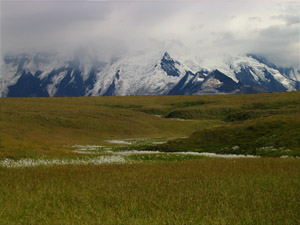 |
We did a little singing to keep ourselves distracted at times along the walk. We are all horrible singers, so it works out ok. And none of us knows very many songs, so we can teach the few we know to each other. |
|
Tonight we are snug in our shelter and back down in the spruce forest. I can hear the howling of the wind outside, and the first raindrops of the trip hitting our roof. Thankfully, I cannot yet feel any of it. But as Hig said, when the weather turns in the mountains, you realize just how far from civilization you really are.
|
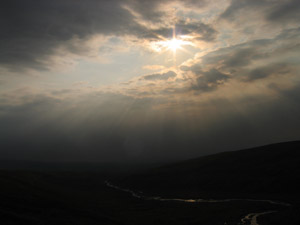 |
 |
|
8/12/04 - day 8 |
| Almost entirely lazy |
 |
Today we wandered three miles upstream. We built two fires, ate two hot meals, and managed to more than make up for the time we gathered by cruising yesterday. But we're still due to lose a few more days somewhere if David doesn't want to hang out in Chitina for too long. | |
|
The grand adventure started with a fire in the dry gully next to our campsite. We sat there, sipped hot drinks, ate Kraft macaroni and cheese, and sat there some more. Hig made spruce root string, while I quickly sketched the gully bottom. Finally, we strolled down the river a little ways to a pond. It was an intense morning. |
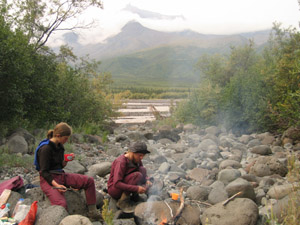 |
We eventually shoved all our crap in the packs and started moving upstream. The Sanford River is huge, and its gravel flats are even larger. Most of the walking was the breeze. And Hig and I had no part in the next adventure. |
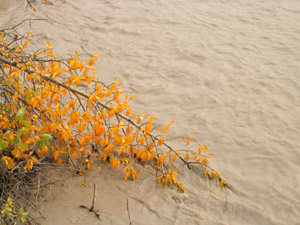 |
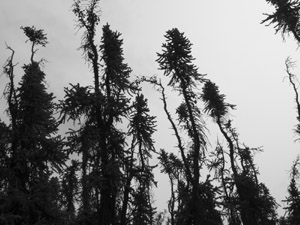 |
|
The river channel we were following butted up against the bank, requiring a few hundred yards of bushwhacking to get back to the gravel plain. Or maybe not. David had crossed the channel on a couple of gravel bars and was out in the middle of the braids.
"What are you doing from here?" he yelled across the water.
"I think we're bushwhacking," Hig yelled back.
"Ok. I'll cross out here and meet you up ahead."
"Be careful!"
With that warning from Hig, we disappeared into the bushes, with David paralleling us on the gravel. He was moving faster than we were. I hadn't wanted to walk out into the braid plains partly because the crossing would be cold and put gravel in my shoes, but mostly because I didn't want to end up out in the middle of the river if things channeled up any more.
We kept on our parallel courses, and as Hig and I came back down from the woods to the river, I remarked "I don't like the look of that crossing David's going to have."
"Well, it's a good thing we went bushwhacking then," Hig replied.
David didn't like the look of that crossing either, because he didn't come back over to our side then. Or a little later. Or a little later than that. He crossed from gravel bar to gravel bar in the middle of the river, wading the fast muddy water. A little farther along our parallel routes, after we'd watched David probe into and back out of several sketchy-looking crossings, Hig and David had a yelled conversation across the channel of rushing water and clacking cobbles. The upshot of this was that David couldn't cross to either side from the gravel bar island he was standing on, and had to go back around.
We took off our packs and shooes, sat down, and watched his progress through binoculars, slightly nervous. Hig mentioned it was possible that the glacial river had even risen significantly in the time since David had first crossed. We wondered if he'd need to use his raft. But he made his way back, managed to cross and avoid the bushwhack, and appeared wet and hungry, with stories of almost being swept down the river while rolling cobbles thumped into his ankles.
A mile or two upstream we ran into a rather more pleasant adventure and a more welcome lesson. There are fish in the Alaska wilderness. I was beginning to wonder if we'd ever catch any at all, we'd been talking about it so much with so little luck. But fish must live in the Sanford River, and they make their way into the dinkiest of streams.
|
|
We were going to stop to fill our water, but we almost didn't bother with fishing. But there was a fish in the little pool, and we'd planned a lazy day anyway, so David got his rod out.
I followed with the camera, since it was a scenic little water course. The first fish surprised me totally. David reeled it out of the water as it flopped and thrashed on the hook. It was a little Dolly Varden, maybe 6 inches long. Not big enough for a meal, but big enough to be part of one, so we threaded it on a stick and kept going upstream. Hig went to set up a fire, and I really hoped we weren't going to be using it for just that one fish.
|  |
|
I needn't have been worried there. Apparently that long skinny stick of carbon fiber really can pull fish out of the water. David said these fish were particularly stupid and naive. They didn't know that food could hurt them, and man that lure must have looked tasty. The small fish started adding up fast. Sometimes he could even pull several from one pool. Hig came up to meet us and managed to catch a few fish in the shallows with just his hands. I became the all-important carrier of the fish stick.
|
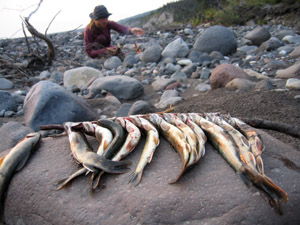 |
We got about a dozen little fish before our stream went up the bank and became covered over in brush. Fish stew is really darn tasty after a week of thinking about fish. And it's calorie free! Neiher the fish nor the dried veggies were included in our calorie rationing, so we ate a whole meal using up nothing more than a little of our olive oil. And it was excellent. We could easily have eaten three times as much if we'd been able to fit that many fish in our pot. |
|
By the time we got walking again, the sun was doing a disappearing act, turning an eerie shade of red as it faded into the smoke. It was gone long before sunset. And then we camped. Just before the next stream crossing, and barely beyond our fishing stream. Our laziness worked out perfectly.
|
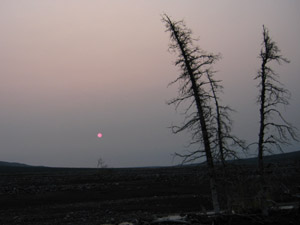 |
|